Method for efficient encoding and decoding quantized sequence in wyner-ziv coding of video
a video and quantized sequence technology, applied in the field of video compression, can solve the problems of increasing the computational complexity of encoding, complicating the code generation process, and undesirable additional encoding computational complexity, so as to reduce the encoding complexity and eliminate the need for binarization
- Summary
- Abstract
- Description
- Claims
- Application Information
AI Technical Summary
Benefits of technology
Problems solved by technology
Method used
Image
Examples
Embodiment Construction
[0025]The encoding side and decoding side of the method of the present invention are shown in FIGS. 4 and 5, respectively.
[0026]In contrast to prior art encoding as illustrated in FIG. 3, the improved encoding of the present invention as shown in FIG. 4 first estimates 410 a field size M from the statistical model 240, then generates an M-ary code 420 from the same statistical model 240 to encode the quantized sequence x directly into a binary sequence z 425.
[0027]To illustrate the encoding process, let us look at FIG. 1. FIG. 1 shows an example of a bipartite graph where on the left hand side of an edge (e.g. items 131 and 132) is a variable node (circle-shaped), and on the right hand side of an edge is a check node (square-shaped). Each variable node carries a value, for example, vi for the ith variable node (counted from top to bottom, items 111 to 118), where i denotes an integer between 1 and 8. Similarly, each check node carries a value, for example, cj for the jth check node ...
PUM
 Login to View More
Login to View More Abstract
Description
Claims
Application Information
 Login to View More
Login to View More - R&D
- Intellectual Property
- Life Sciences
- Materials
- Tech Scout
- Unparalleled Data Quality
- Higher Quality Content
- 60% Fewer Hallucinations
Browse by: Latest US Patents, China's latest patents, Technical Efficacy Thesaurus, Application Domain, Technology Topic, Popular Technical Reports.
© 2025 PatSnap. All rights reserved.Legal|Privacy policy|Modern Slavery Act Transparency Statement|Sitemap|About US| Contact US: help@patsnap.com



